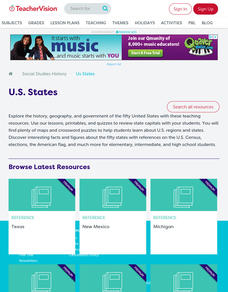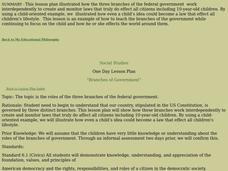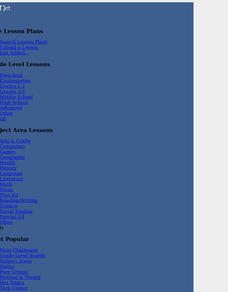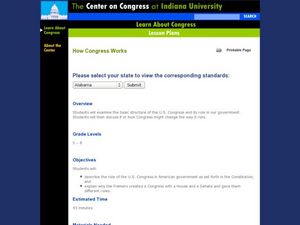Curated OER
Explicit and Implicit Language - Interpreting the Meaning of the Fourteenth Amendment
Students write an essay analyzing the language of the Fourteenth Amendment to the US Constitution. In this US History lesson plan, students review the difference between implicit and explicit meanings. Students watch a video...
Curated OER
U.S. President: Facts
Learners gather information from a chart. They become familiar with the names of the presidents of the United States. They complete a worksheet imbedded in this plan on the many facts associated with the Presidents.
Curated OER
Washington, D. C.: Crossword Puzzle
In this United States history worksheet, students use the 14 clues in order to fill in the crossword puzzle with the appropriate answers pertaining to Washington, D. C.
Curated OER
Lesson Two: The Federalist Papers
Students identify Articles of Confederation and explain why it failed, explain argument over need for Bill of Rights in Constitution and James Madison's role in securing it's adoption, and compare and contrast ideas of Federalists and...
Curated OER
European Union: Myths and facts
Learners examine the difference between myths and facts presented about the European Union. They read and discuss articles about the EU and its role in European politics by evaluating a referendum to the EU constitution.
Curated OER
The U.S. & Navajo Bills of Rights
Middle schoolers are introduced to the United States and Navajo Bill of Rights. In groups, they compare and contrast the two documents and take notes to share with the class. To end the lesson, they write in their journals about their...
National Endowment for the Humanities
Magna Carta: Cornerstone of the U.S. Constitution
High schoolers use the Internet to read a brief description of Magna Carta (link provided). They "walk through" the document with the teacher, identifying four major themes. Students read and discuss "The Rhetoric of Rights: Americans...
Curated OER
Branches of Government
Young scholars explore the three branches of government. In this government and U.S. history lesson, students listen to a story about a boy who attempts to sponsor a bill to ban cartoons. Young scholars interview three teachers who each...
Curated OER
The Beginnings of Constitutional Government
Students examine excerpts of Thomas Paine's Common Sense. For this early American history lesson, students read Paine's pamphlet and analyze the information according the rubric provided.
Curated OER
Bill Of Rights
Students examine Supreme Court cases. In this U.S. government lesson, students watch a video about the Bill of Rights and then research 4 Supreme Court cases using the noted web site. Students analyze the presented information and write...
Curated OER
The Constitution
A study of the Constitution can lead students into an exploration of civil rights, laws, and history.
Curated OER
Bill of Rights: Rights and Responsibilities
Students explore the meaning of freedom. In this U.S. History instructional activity, students research the Declaration of Independence and how it relates to American freedom by completing activities and a mock trial.
Curated OER
Fairy Tails Can Show Due:It can happen for you, If you play your part.,
Learners view a Reader's Theater focusing on the story of Goldilocks and the Three Bears. The story is used as a springboard into a videotaped mock trial of Gold E. Locks developed by the American Board of Trial Advocates (ABOTA). They...
Curated OER
Can I Have a Jury Trial?
Students examine the difference between a jury trial and a bench trial. They discuss any protections that the Indiana and United States Constitution offers its citizens. They use the internet to research any current press of jury trials.
Curated OER
Are We Free Yet?
Students read excerpts from several Freedom Documents, evaluate amount of freedom guaranteed by each document, and rank documents on scale to determine which grant greatest and least amount of personal freedom.
Curated OER
The Supremes
High schoolers discuss steps cases go through to reach Supreme Court, examine Bill of Rights, and rank rights in order of importance to them. Students then research Supreme Court case dealing with one of first ten amendments, and write...
Curated OER
First Amendment Guarantee of Free Speech (Senior, Social Studies)
High schoolers receive a list of banned books from which they choose one to read. They read their chosen book and write a paper that includes a discussion of the First Amendment and its guarantees and the reason(s) why they believe their...
Curated OER
Arrests and Investigatory Stops
Students define arrest and detainment, examine hypothetical situations to determine if warrantless arrest/detainment is reasonable based on information available to police, discuss differences between hunch, suspicion, reasonable...
Curated OER
Presidents
Students identify the qualities needed to become President of the United States. Using the internet, they discover the differences in character of past presidents and draw conclusions about their time in office. They relate a piece of...
Curated OER
How Congress Works
Students describe role of the U.S. Congress in American government as set forth in the Constitution, and explain why the Framers created a Congress with a House and a Senate and gave them different roles.
Curated OER
Ask Me What's Great About America
Students pretend to be citizens of a new space colony and have been elected to the Intergalactic Senate to consider adding a Bill of Rights to the Constitution. They break into groups and discuss what seems unfair and fair about the...
Center for History Education
Helping to Move On? An Analysis of the Reconstruction Amendments
Reconstruction amendments: a helping hand or another form of slavery? An inquisitive lesson compares the Reconstruction legislation that ended slavery, granted citizenship, and protected voting right for African American men. Scholars...
K12 Reader
Responsibilities of Citizenship
Your pupils are all citizens of your classroom. Provide some more instruction on how people can be citizens with the reading passage included here. After reading, learners answer the five related questions.
College Board
Balance of Power Between Congress and the President
Three branches of government help create a system of checks and balances. A helpful resource provides a series of articles regarding the balance of power between the legislative and executive branches of government. Historians answer...

























